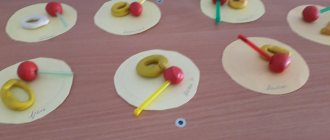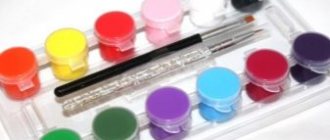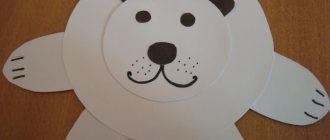Summary of a game lesson in the younger group
Objectives of specially organized educational activities:
cognitive development: to reinforce with children the concepts of one-many, big-small;
speech development: develop and form grammatically correct speech, the ability to answer questions, activate and expand vocabulary;
social and communicative development: develop the ability to interact with each other and the teacher;
artistic and aesthetic development: learn to create a bright, imaginative picture using colored paper, enrich children’s impressions with musical accompaniment;
physical development: develop fine motor skills of the hands.
Preliminary work:
- conversations about autumn;
- reading works of art: poems about autumn by A. S. Pushkin, E. Blaginina.
Materials and equipment:
Soft toy Phil, a CD with music, paper cut out leaves (of different sizes and colors), a basket, a sheet of Whatman paper with trees and shrubs drawn on it, glue, oilcloths, napkins.
Progress of the lesson
Children are sitting on the carpet. Filya appears in the group. Says hello to the guys.
Educator: Guys, look who came to visit us. Do you know who this is?
That's right, this is Filya from the children's program “Good Night Kids.” Filya came to visit us and brought us this disc so that we could listen to it. Let's listen carefully!
Listening to a story about autumn and a short piece of music.
At the end of the melody, the teacher places leaves of different sizes and colors on the carpet.
Educator: The wind blew and leaves flew to our group. How many leaves have arrived to us? Children's answers.
What is it called when many leaves fall at once? (Leaf fall.)
What color are the leaves on our carpet? (Children’s answers. Consolidating knowledge of primary colors.)
Educator: Find me the largest, smallest leaf.
What color are they? And this one? Etc.
How many big yellow leaves? (One.)
How many other leaves? (A lot of.)
Now you and I will take one leaf at a time and spin in an autumn dance. We will be like autumn leaves.
Music is playing. Children dance with leaves together with the teacher.
After the dance, the children put the leaves in a basket.
Educator: Filya wants to tell us something.
— Guys, the artist gave me a painting. There is a tree and a bush on it, but they have no leaves at all and the leaves don’t fly around. She's not pretty at all.
Educator:
- Don’t be sad Phil, we will help you. Let's guys decorate this picture and stick autumn leaves on it. Now everyone will come to the table, take a leaf of any color, name the color of the leaf and stick it anywhere in the picture.
Children glue the leaves onto a previously prepared sheet with a tree and shrub. Music is playing.
Educator: Look, Phil, do you like the picture now?
— Filya: Yes, very much. But I forgot what time it is when the leaves fall? Guys, remind Phil when the leaves begin to fall, what color the leaves are in the picture. Children's answers.
Educator: Phil, we are returning your painting to you, the children worked very hard for you, your painting has become bright and elegant. You can go home and hang the picture on the wall.
— Filya thanks the children and says goodbye.
Junior group. Early childhood, nursery. Children 1-4 years old
Summary of a lesson in modeling and drawing in the first junior group (2–3 years old) “Collective work “Around the Christmas tree”
Lesson notes in 1 ml . group (2-3 years old. Group work. Modeling. Finger painting. Topic: “Around the Christmas tree”
. Goal: To develop aesthetic perception in children, to teach them to convey the image of a decorated Christmas tree through plasticine. Objectives: 1. To develop fine motor skills in children….
Summary of the lesson “Winter-winter” in the early age group
Summary of a lesson in an early age group from 1.6 to 4 years old on the topic “Winter - Winter”
Goal: expanding children's knowledge about winter natural phenomena. Objectives: Educational: Learn to guess poems - riddles; To consolidate children's knowledge about the characteristic signs of winter; Form a concept about...
Complex lesson in the first junior group “Toys”
Program content:
- strengthen children's ability to distinguish colors and knowledge of geometric shapes
- consolidate the ability to recite a poem by clearly pronouncing the words
- form an idea of size: big, small
- strengthen the ability to hold a hand with three fingers
- develop attention, independence, aesthetic taste
- cultivate kindness and an emotionally positive attitude towards the characters.
Methodological techniques : surprise moment, games, questions for children, productive activities of children.
Preliminary work: memorizing poems by A. Barto, didactic games “Guess what color”, “Kids and paints”, and others, drawing.
Move
Surprise moment.
The teacher listens: “Children, who is coming to us?” (A horse and cart rides out.) Who came to us? (Horse). Who knows a poem about a horse?
Nursery rhyme about a horse “I love my horse.”
“The horse is very happy that the children take such good care of it.” That's how she laughs, "Igo-go." She brought you a gift, a big beautiful box. And there are also boxes in it, all of different colors. What color is this box (red), let's see what's in it (wet bunny). Oh, what happened to the bunny? (He got wet). Why do you think he got wet? Who knows the poem about a bunny (“The bunny was abandoned by the mistress…”).
Poem about a bunny.
How can you help him so that next time it rains he doesn’t get wet? (You can give an umbrella, ....). He has an umbrella, look, but it’s all tattered, full of holes, how can it be repaired?
Didactic game “Patch the Umbrella”.
- I’ll give you patches, what do you think they look like? (On the figures). Take the pieces and fix the umbrella.
- Well done guys, the bunny is very happy! He says thank you! Let's look at another box, what color is it? (Blue). Who are these guys? (Bear). Who knows a poem about a bear?
Poem about a bear.
- And the bear didn’t come alone, his friend came with him. What are they like, look at them? (One big, one small).
Exercise "Many - One."
- Guys, after a cone fell on the bear’s forehead, the bears are now afraid to collect cones in the forest, let us help them collect cones. They brought two baskets with them, what one basket? (large), and the other? (small). Guys, how many big baskets are there? (1) . How many small baskets? (1). And how many cones (many)
Game "Collect cones". — The guys are different cones, big and small. We need to collect large cones in a large basket, and small ones in a small one. Well done guys for helping the bears, they couldn’t have done it without you.
-Now let’s open the next box, what color is it? (Yellow). Let's see what's in it? Who are these guys? (Butterfly). Guys, the butterfly was lying in a box and was tired, it needed to stretch its wings. Let's play with her together.
Outdoor game "Butterfly". In the morning the butterfly woke up, smiled, stretched, once - it washed itself with dew, two - it circled gracefully, three - it bent down and sat down, and flew away on four.
Practical work. Blotgraphy “Butterfly”. -Well done boys! While the butterfly was sitting in the box, her friends flew far, far away. Now she was left completely alone. Let's draw some girlfriends for her. Make yourself comfortable. Look at my paper, it opens and closes like a book. I will draw on one side of the sheet. I take the brush with three fingers near the iron tip, dip it in yellow paint and draw blots. Then I wash my brush and dip it in red paint; when I draw a blot, I also wash it and put blue paint on the brush. I only draw on one half of the sheet; remember, my sheet is bent like a book. I wash the brush and put it in the stand, close the sheet like a book, and iron it. I open it. What did I get? (Butterfly).
-Guys, the horse has one more box left, what color is it? (Multi-colored). Oh, guys, the horse brought us some gifts, what should we say to the horse? Thanks horse!
Author: Hanafieva Guzaliya Nailovna, teacher of the MADOU Kindergarten No. 6 “Sun”, Dyurtyuli, Republic of Bashkortostan.
The article is published in the author's edition.



